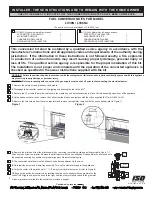
9
Just as with any other vented device, vertical vent rise creates draft (negative pressure) in the firebox as the
exhaust gases heat up. If this draft becomes excessive, it can affect the performance or appearance of the
fire. The Slim 26 fireplace includes air and exhaust restrictors that are used to balance the draft in the fire-
place to the optimal level for installations where excessive draft might occur. The venting charts on pages
10 and 11 provide an easy means for determining whether your specific installation requires inlet air or ex-
haust restrictors or both. To make the determination about whether air or exhaust restrictors are needed, a
venting chart worksheet is provided on page 12. Follow the instructions and fill in the worksheet for your
particular installation. This will allow you to determine the recommended restrictor settings for your exact
installation. Although this might appear to be a complicated process at first glance, it is really quite
straight-forward and the result will be a fire that looks and performs as intended. Several examples of
worksheet calculations are shown on page 13 to help guide you.
Please be sure to note that:
1. There are separate venting charts for Natural Gas and LP Gas. Refer to the appropriate chart for your
fuel type to determine your specific restrictor requirements. The settings in the charts have been deter-
mined based on extensive testing.
2. Determine the total vertical vent rise and total horizontal vent run for your installation. All measure-
ments are made from the center of the vent opening in the back of the fireplace.
3. If your fireplace will not be venting directly though an outside wall to a horizontal termination or if
more than 30” of horizontal vent run is required, some vertical vent rise will be required for the fire-
place to function and vent properly. Elbows will also be required for those installations. However, in-
stallations are limited to a maximum of four 90° elbows (or 45° elbow equivalents).
4. Note: Two 45° elbows equal one 90° elbow.
5. The recommended restrictor settings in the venting charts allow up to two 90° elbows (or 45° elbow
equivalents) to be used without affecting the restrictor settings. Additional elbows will require that you
calculate a new equivalent horizontal run for your installation to account for the additional flow resis-
tance caused by the extra elbows. For the purposes of calculating the equivalent horizontal vent run,
each additional 90° elbow is equivalent to three feet of horizontal vent run. The total horizontal vent
run including elbow equivalents can not exceed 10 feet.
6. The maximum vertical vent rise can not exceed 20 feet.
7. There are two exhaust restrictors that are provided with your Slim 26 fireplace. They are labeled “A”
and “B”. The A restrictor provides less exhaust restriction than B.
8. An air restrictor plate is also provided with your fireplace. It is a ring with bendable tabs that can be
set to adjust the amount of restriction in the air supply system. Once the appropriate number tabs are
bent open (in accordance with the requirements for your installation), the plate is inserted between the
fireplace and the vent starter pipe.
USING THE VENTING CHARTS
The location of the vent termination must meet the requirements of the current edition of ANSI Z223.1/
NFPA 54, National Fuel Gas Code or CAN B419.1, Natural Gas and Propane Installation Code and the
requirements shown on page 15 of this manual.










































